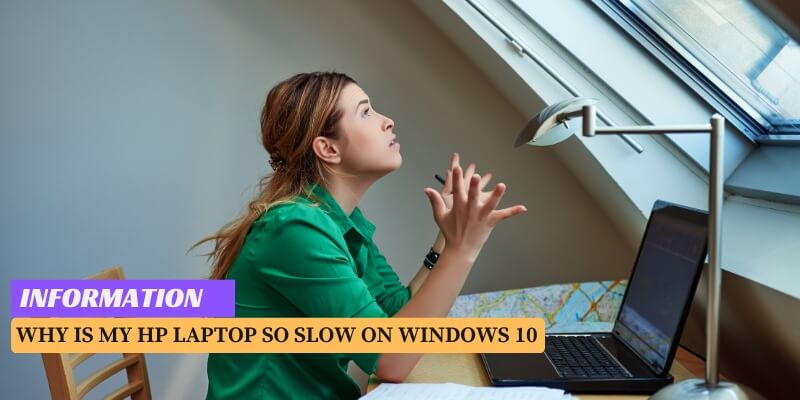Your HP laptop may be slow on Windows 10 due to a variety of factors, such as too many startup programs, insufficient memory, or a fragmented hard drive.
Introducing a solution to your slow HP laptop on Windows 10 is essential to help improve its performance and efficiency.
A slow laptop can hamper productivity, cause frustration, and impact overall user experience.
There are several reasons why your HP laptop may be slow on Windows 10, including excessive startup programs, inadequate memory, and a fragmented hard drive.
Fortunately, there are effective strategies to address these issues and restore your laptop’s speed and responsiveness.
By following the right steps, you can optimize your laptop’s performance and enjoy a smoother computing experience.
This article examines these potential causes and provides practical solutions to resolve the slowness issue on your HP laptop running Windows 10.
Table of Contents
Understanding The Common Causes Of Slow Performance
Understanding the common causes of slow performance in your HP laptop running Windows 10 is key to optimizing its speed and efficiency.
By identifying these common issues, you can take the necessary steps to improve your laptop’s performance and enjoy a smoother user experience.
In this article, we will explore three common causes of sluggishness in Windows 10 and provide practical solutions to address them.
Overloaded Startup Programs
One of the primary culprits behind a slow-performing HP laptop running Windows 10 is an overloaded list of startup programs.
When you power on your laptop, numerous programs automatically initiate and run in the background, consuming valuable system resources.
As a result, your laptop struggles to allocate enough resources to other essential tasks, leading to a sluggish performance.
To tackle this issue, it is essential to manage your startup programs effectively. Here’s how:
- Open the Task Manager by pressing
Ctrl + Shift + Esc. - Navigate to the “Startup” tab.
- Review the list of programs and identify the ones you can disable.
- Right-click on the program you want to disable and select “Disable” from the context menu.
- Repeat this process for all unnecessary programs.
By reducing the number of startup programs, you can significantly improve your HP laptop’s boot time and overall performance.
Insufficient Memory
Insufficient memory is another common cause leading to slow performance on your HP laptop.
When your laptop’s RAM is overwhelmed by the demands of running multiple applications simultaneously, it resorts to using your hard drive as virtual memory, which is significantly slower.
This swapping process can considerably slow down your laptop’s performance.
To address this issue, consider the following solutions:
- Upgrade your RAM to a higher capacity.
- Close unnecessary applications and tabs running in the background.
- Use a reliable system optimization tool to free up memory.
By addressing the issue of insufficient memory, you can enhance your laptop’s performance and ensure smooth multitasking.
Fragmented Hard Drive
A fragmented hard drive is yet another factor contributing to slow performance on your HP laptop.
Over time, files become fragmented, meaning they are scattered across various sectors of your hard drive. As a result, it takes your laptop longer to access these files, leading to slower overall performance.
To resolve this issue, consider the following steps:
- Open the Disk Defragmenter by searching for it in the Windows search bar.
- Select the drive you want to defragment.
- Click on “Optimize.”
- Wait for the defragmentation process to complete.
By defragmenting your hard drive regularly, you can organize your files more efficiently and enjoy improved performance on your HP laptop.
By understanding and addressing these common causes of slow performance on your HP laptop running Windows 10, you can optimize its speed, enhance user experience, and boost overall productivity.
Optimizing Startup Programs For Improved Performance
Is your HP laptop running painfully slow on Windows 10? One common culprit for this issue is the number of startup programs running when you start your laptop.
The more programs that automatically open upon startup, the longer it takes for your laptop to boot up and become usable.
Fortunately, you can optimize your startup programs to improve the overall performance of your HP laptop.
In this article, we will guide you through the process of identifying and disabling unnecessary startup programs using the Task Manager.
identifying disabling startup programs identifying And Disabling Unnecessary Startup Programs
The first step in optimizing your startup programs is to identify which programs are actually necessary and which ones can be disabled.
Disabling unnecessary startup programs not only helps in improving the laptop’s performance but also ensures that your system resources are not being consumed unnecessarily.
Here’s how you can identify and disable unnecessary startup programs on your HP laptop:
- Press Ctrl+Shift+Esc keys on your keyboard to open the Task Manager.
- In the Task Manager window, click on the “Startup” tab.
- You will see a list of all the programs that are set to start automatically when your laptop boots up.
- Go through the list and identify the programs that you don’t need to start automatically.
- Right-click on the program and select “Disable” to prevent it from starting up automatically.
- Repeat this process for all the unnecessary programs.
By disabling unnecessary startup programs, you can significantly reduce the boot time of your HP laptop and improve its overall performance.
using task manager manage startup program using Task Manager To Manage Startup Programs
The Task Manager is a powerful tool built into Windows 10 that helps you manage and monitor the processes running on your computer.
It can also be used to manage your startup programs and improve the performance of your HP laptop.
Follow these steps to manage your startup programs using the Task Manager:
- Open the Task Manager by pressing Ctrl+Shift+Esc keys on your keyboard.
- Click on the “Startup” tab.
- You will see a list of all the programs that start automatically when your laptop boots up.
- Here, you can enable or disable startup programs by right-clicking on them and selecting the corresponding option.
Using the Task Manager, you can easily enable or disable startup programs as per your requirement. It allows you to have better control over your HP laptop’s boot time and performance.
By optimizing your startup programs, you can significantly improve the performance of your HP laptop running on Windows 10.
Identifying and disabling unnecessary startup programs using the Task Manager can help reduce the boot time and free up system resources, enhancing the overall speed and responsiveness of your laptop.
Boosting Performance With Increased Memory
If you’re experiencing a sluggish performance on your HP laptop running Windows 10, one of the most effective solutions is to upgrade the memory.
Increasing the memory capacity of your laptop can significantly improve its overall performance, allowing you to multitask effortlessly and run resource-intensive applications without any lag.
In this guide, we will explore the steps to determine the required memory upgrade and walk you through the process of installing additional RAM on your HP laptop.
Determining The Required Memory Upgrade
Before diving into the installation process, it’s essential to determine the exact amount of memory you need to upgrade.
Upgrading too little memory may not solve the performance issues, while upgrading unnecessarily can be costly.
To find out how much memory you currently have and assess the upgrade requirements, follow these steps:
- On your HP laptop, press the Windows key and type “System” in the search bar.
- Click on the “System” app from the search results to open the System Information window. Alternatively, you can press the Windows key + Pause/Break key combination to directly open the System Information window.
- In the System Information window, under the “System Summary” section, look for the “Installed Physical Memory (RAM)” listing. This will display the total amount of memory installed on your laptop.
- Note down the installed memory size (in gigabytes) for future reference. This will be useful while determining the required memory upgrade.
Installing Additional Ram
Once you have determined the required memory upgrade, it’s time to proceed with installing additional RAM on your HP laptop. Here’s a step-by-step walkthrough:
- Start by ensuring you have the compatible RAM module for your HP laptop. Refer to the laptop’s manual or visit the official HP website for information on compatible RAM modules.
- Power off your laptop and disconnect all external peripherals.
- Locate the memory compartment on your HP laptop. It is usually located at the bottom of the laptop and may require removing a panel or battery to access it.
- Once you have access to the memory compartment, gently remove the existing RAM module by pushing the clips or levers on the sides.
- Take your new RAM module and align the notches with the memory slot. Insert the module at a 45-degree angle and press it firmly until it clicks into place.
- Double-check the alignment of the RAM module and ensure it is securely installed.
- If you have multiple memory slots, repeat the process for each slot.
- Reassemble any removed panels or batteries, and connect all external peripherals.
- Finally, power on your HP laptop and verify the increased memory capacity by checking the “Installed Physical Memory (RAM)” in the System Information window.
Upgrading the memory of your HP laptop can breathe new life into its performance.
By following the steps outlined above, you can determine the required memory upgrade and seamlessly install additional RAM, enabling your laptop to handle demanding tasks effortlessly and providing a smoother Windows 10 experience.
Resolving Performance Issues With A Fragmented Hard Drive
Are you starting to feel frustrated with your HP laptop running Windows 10? Is it taking longer than usual to load programs and access files?
One possible culprit could be a fragmented hard drive, a common performance issue that can slow down even the most powerful computers.
In this blog post, we will explore the causes of a fragmented hard drive and discuss two effective solutions: using the built-in Disk Defragmenter tool and using third-party disk defragmentation software.
Using The Built-in Disk Defragmenter Tool
If you’re looking for a simple and straightforward way to resolve performance issues caused by a fragmented hard drive, look no further than the built-in Disk Defragmenter tool in Windows 10.
This tool analyzes your hard drive, identifies fragmented files, and rearranges them to optimize performance.
Using the Disk Defragmenter tool is easy. In just a few simple steps, you can give your HP laptop’s hard drive a much-needed boost:
- Open the Start menu and search for “Disk Defragmenter”.
- Click on the “Defragment and Optimize Drives” option from the search results.
- Select your hard drive from the list and click on the “Optimize” button.
- Wait for the tool to analyze and defragment your hard drive. This process may take some time, especially if your hard drive is heavily fragmented.
- Once the defragmentation process is complete, you should notice a significant improvement in your laptop’s overall performance.
Using Third-party Disk Defragmentation Software
If you’re looking for more advanced features and options to address the fragmentation issues on your HP laptop, consider using third-party disk defragmentation software.
These applications often provide additional features, such as scheduling automatic defragmentation and optimizing specific files or folders.
There are several reliable third-party disk defragmenter software available, such as Defraggler, UltraDefrag, and Smart Defrag. Here’s how you can benefit from using them:
- Schedule automatic defragmentation: These tools allow you to set up an automatic defragmentation schedule, ensuring that your hard drive is regularly optimized without any manual intervention.
- Optimize specific files or folders: With third-party software, you can prioritize certain files or folders for defragmentation, ensuring that your most-used applications and files are always in the best possible state.
So, if you want to take your HP laptop’s performance to the next level, consider using third-party disk defragmentation software.
With their advanced features and customization options, they can effectively tackle the fragmentation issues that may be slowing down your laptop.
Additional Tips And Tricks To Speed Up Your Hp Laptop
If you find that your HP laptop running Windows 10 is still running slow, don’t worry! There are additional tips and tricks you can try to optimize its performance and make it faster.
In this section, we will discuss three effective methods:
Cleaning Out Unwanted Files And Programs
Cleaning out unwanted files and programs from your HP laptop is an essential step towards improving its speed and efficiency.
Over time, your laptop accumulates unnecessary files, temporary internet files, and leftover program files, which can clutter your system and slow it down.
To clean out these unwanted files, follow these steps:
- Press the Windows key + R to open the Run dialog box.
- Type “%temp%” (without the quotes) and press Enter. This will open the Temp folder.
- Select all the files and folders in the Temp folder and delete them.
- Next, open the Run dialog box again and type “temp” (without quotes). Press Enter to open the Temp folder.
- Delete all the files and folders in the Temp folder.
- Finally, open the Recycle Bin on your desktop and empty it to permanently delete the files.
- To remove unwanted programs from your laptop, go to Settings > Apps & Features. Select the program you want to uninstall and click the Uninstall button.
Optimizing Power Settings For Better Performance
Optimizing power settings can significantly boost your HP laptop’s performance.
By default, Windows 10 is designed to balance performance and battery life, but if you’re willing to sacrifice some battery life for better speed, you can adjust the power settings.
Follow these steps:
- Click on the Battery icon in the system tray and select Power & sleep settings.
- Click on Additional power settings to open the Power Options window.
- Select the High performance power plan.
- If the High performance plan is not available, click on Create a power plan and select the High performance option.
- Click Next and give your new power plan a name. Click Create to apply the settings.
Performing Regular Os Updates
Regularly updating your operating system is crucial for maintaining the performance and security of your HP laptop.
Windows 10 updates include bug fixes, performance improvements, and security patches that can directly impact your laptop’s speed.
To perform regular operating system updates, follow these steps:
- Click on the Start menu and select Settings.
- In the Settings window, click on Update & Security.
- Click on Windows Update in the left sidebar.
- Click on Check for updates and wait for Windows to search for available updates.
- If updates are found, click on Download and install to start the update process.
- Restart your laptop after the installation is complete to apply the updates.
By cleaning out unwanted files and programs, optimizing power settings, and performing regular OS updates, you can significantly improve the speed and performance of your HP laptop running Windows 10.
Give these tips and tricks a try and enjoy a faster and smoother computing experience!
FAQs On Why Is My Hp Laptop So Slow Windows 10
How Do I Fix My Hp Laptop From Running Slow Windows 10?
1. Remove unnecessary startup programs.
2. Clear temporary files and free up disk space.
3. Disable visual effects and adjust power settings.
4. Update drivers and software.
5. Run a malware scan and optimize your hard drive.
How Can I Speed Up My Hp Laptop Windows 10 Pro?
1. Remove unnecessary startup programs.
2. Update your drivers and software regularly.
3. Clean up your hard drive by deleting unnecessary files.
4. Disable visual effects and adjust power settings.
5. Upgrade your RAM if needed.
How Do I Clean Up My Hp Computer To Make It Run Faster?
1. Uninstall unnecessary programs and files.
2. Remove temporary files and clear cache.
3. Disable startup programs that are not necessary.
4. Run a virus scan and remove any malware.
5. Ensure your computer’s operating system and software are up to date.
Why Does My Hp Laptop Take So Long To Load?
Why Is My Hp Laptop Running So Slow On Windows 10?
How Can I Speed Up My Hp Laptop On Windows 10?
Does Upgrading Ram Improve The Performance Of My Hp Laptop?
Is It Necessary To Update The Bios On My Hp Laptop?
Can A Virus Or Malware Slow Down My Hp Laptop?
How Do I Optimize The Startup Process On My Hp Laptop?
Conclusion of Why Is My Hp Laptop So Slow Windows 10
To conclude, if you’re wondering why your HP laptop is running slow on Windows 10, several factors could be at play.
From outdated drivers and software conflicts to excessive startup programs and insufficient memory, troubleshooting and optimizing your laptop’s performance can make a significant difference.
By following the tips and solutions mentioned in this blog post, you can help improve the speed and efficiency of your HP laptop and enjoy a smoother experience.






